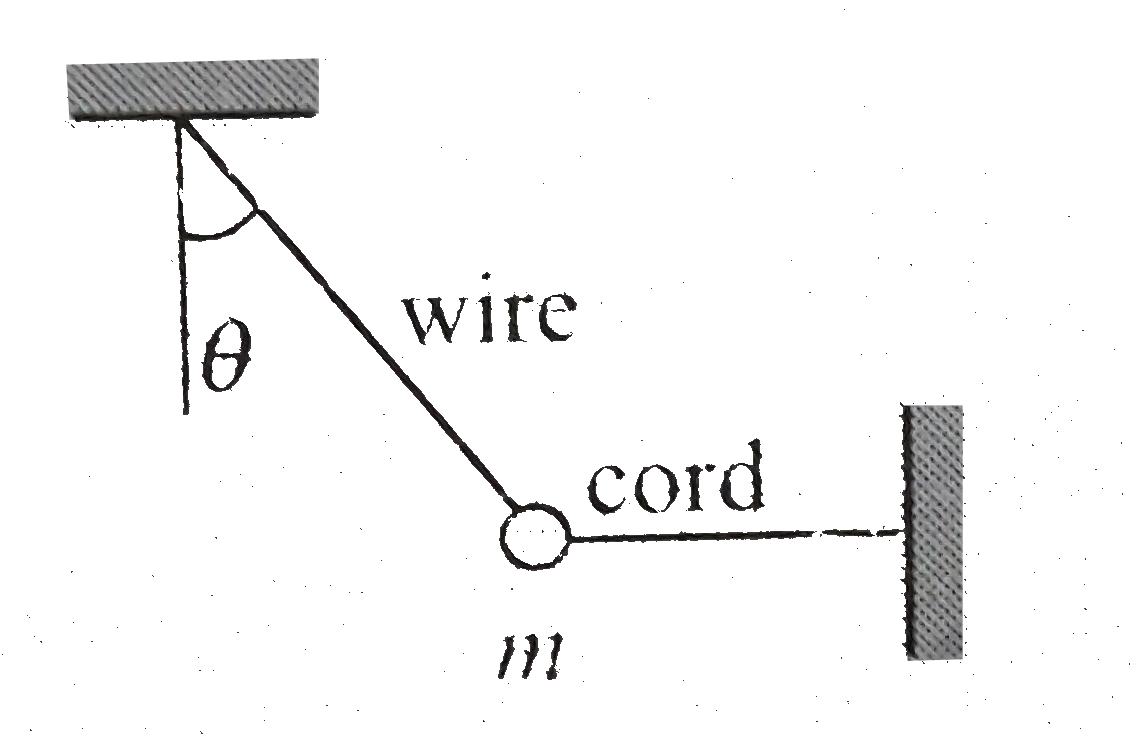What happens to the (i) extension (ii) maximum load, a wire can bear, when the wire is cut into half?
To solve the question regarding what happens to the extension and maximum load a wire can bear when it is cut into half, we will analyze each part step by step.
1. Initial Setup:
- Let the initial length of the wire be L.
- Let the initial extension be ΔL1.
2. Young's Modulus Definition:
- Young's modulus Y is defined as the ratio of stress to strain:
Y=StressStrain=F/AΔL/L
- Rearranging gives:
ΔL=F⋅LA⋅Y
- This is our equation for initial extension ΔL1.
3. Cutting the Wire:
- When the wire is cut into half, the new length L2 becomes L/2.
4. New Extension Calculation:
- The new extension ΔL2 can be calculated using the same formula:
ΔL2=F⋅L2A⋅Y=F⋅(L/2)A⋅Y=12⋅F⋅LA⋅Y=12ΔL1
- Therefore, when the wire is cut in half, the extension is reduced to half.
Conclusion for Extension:
- The extension of the wire when cut in half is reduced to half of the original extension.
---
(ii) Effect on Maximum Load:
1. Understanding Maximum Load:
- The maximum load Fmax that a wire can bear is related to the breaking stress σ and the cross-sectional area A:
Fmax=σ⋅A
- Breaking stress is defined as the maximum stress a material can withstand before failure.
2. Independence from Length:
- It is important to note that the breaking stress and the cross-sectional area are properties of the material and do not depend on the length of the wire.
3. Conclusion for Maximum Load:
- Since the maximum load is dependent only on the breaking stress and the area, and not on the length, cutting the wire in half does not change the maximum load it can bear.
- Therefore, the maximum load remains constant.
---
Final Answers:
- (i) The extension of the wire is reduced to half when the wire is cut into half.
- (ii) The maximum load that the wire can bear remains constant when the wire is cut into half.
---
- Let the initial length of the wire be L.
- Let the initial extension be ΔL1.
- Young's modulus Y is defined as the ratio of stress to strain:
Y=StressStrain=F/AΔL/L
- Rearranging gives:
ΔL=F⋅LA⋅Y
- This is our equation for initial extension ΔL1.
- When the wire is cut into half, the new length L2 becomes L/2.
- The new extension ΔL2 can be calculated using the same formula:
ΔL2=F⋅L2A⋅Y=F⋅(L/2)A⋅Y=12⋅F⋅LA⋅Y=12ΔL1
- Therefore, when the wire is cut in half, the extension is reduced to half.
- The extension of the wire when cut in half is reduced to half of the original extension.
- The maximum load Fmax that a wire can bear is related to the breaking stress σ and the cross-sectional area A:
Fmax=σ⋅A
- Breaking stress is defined as the maximum stress a material can withstand before failure.
- It is important to note that the breaking stress and the cross-sectional area are properties of the material and do not depend on the length of the wire.
- Since the maximum load is dependent only on the breaking stress and the area, and not on the length, cutting the wire in half does not change the maximum load it can bear.
- Therefore, the maximum load remains constant.
- (i) The extension of the wire is reduced to half when the wire is cut into half.
- (ii) The maximum load that the wire can bear remains constant when the wire is cut into half.
Topper's Solved these Questions
- PROPERTIES OF MATTERBOOK - ICSECHAPTER - PROPERTIES OF MATTEREXERCISE - MODULE 1 (ELASTICITY)LONG ANSWER QUESTIONS
5 Videos
- PROPERTIES OF MATTERBOOK - ICSECHAPTER - PROPERTIES OF MATTEREXERCISE - MODULE 1 (ELASTICITY)SHORT ANSWER QUESTIONS
20 Videos
- PROPERTIES OF MATTERBOOK - ICSECHAPTER - PROPERTIES OF MATTEREXERCISE - MODULE 1 (ELASTICITY)
2 Videos
- OSCILLATIONS BOOK - ICSECHAPTER - OSCILLATIONS EXERCISE - SELECTED PROBLEMS (OSCILLATION IN A TUNNEL BORED THROUGH THE EARTH)
2 Videos
- SAMPLE QUESTION PAPER - 01 BOOK - ICSECHAPTER - SAMPLE QUESTION PAPER - 01 EXERCISE - SECTION - D
12 Videos
Similar Questions
Knowledge Check
The maximum load a wire can withstand without breaking, when its length is reduced to half of its original length, will
Abe doubleBbe halfCbe four timesDremain same.
The two wires shown in figure are made of the same material which has a breaking stress of 8×108Nm−2. The area of cross section of the upper wire is 0.006cm2 and that of the lower wire is 0.003cm2. The mass m1=10kg, m2=20kg and the hanger is light. a. Find the maximum load that can be put on the hanger without breaking a wire. Which wire will break first if the load is increased? b. Repeat the above part m1=10kgandm2=36kg.

View SolutionThe maximum load that a wire can sustain is W. If the wire is cut to half its value, the maximum load it can sustain is
View SolutionThe maximum load a wire can withstand without breaking, when its length is reduced to half of its original length, will
View SolutionThe stress strain graph for a metal wire is shown in the fig. Up to the point E, the wire returns to its original state O along the curve EPO, when it is gradually unloaded. Point B corresponds to the fracture of the wire.

(a) Up to what point on the curve is Hooke's law obeyed? (this point some times called proportional limits).
(b) Which point on the curve corresponding to elastic limit or yield point of the wire?
(c ) Indicate the elastic and plastic regions of the stress-strain graph.
(d) Describe what happens when the wire is loaded up to a stress corresponding to the point A on the graph and then unloaded gradually. In particular explain the dotted curve.
(e) What is peculiar about the portion of the stress- strain graph from C to B? Up to what stress can the wire be subjected without causing fracture?
View SolutionA 10 m long nichrome wire having 80Ω resistance has current carrying capacity of 5 A. This wire can be cut into equal parts and equal parts can be connected in series or parallel. What is the maximum power which can be obtain as heat by the wire from a 200 V mains supply? (in kW)
View SolutionA small mass m and its supporting wire because a simple pendulum when the horizontal cord is cut . Find the ratio of the tension in the supporting wire immediately after the cord is cut to the tension in the wire before the cord is cut

View SolutionA wire of cross-sectional area A breaks due to its own weight when length of the wire is l. If area of cross-section of the wire is made 3A then maximum length of the wire can be hung without breaking is
View Solution
_E01_781_Q01.png)